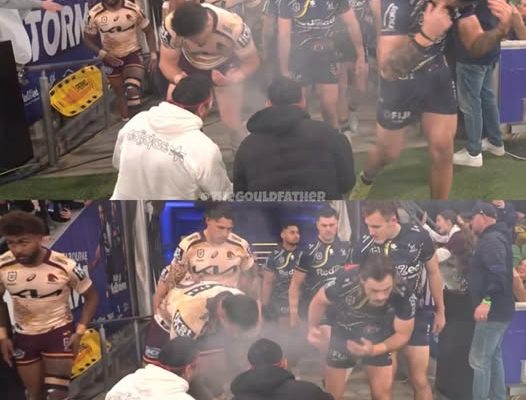Rumors have recently surfaced claiming that Ezra Mam, the talented young rugby league player, was injured after refusing to take part in an Indigenous smoke ceremony during the NRL’s Indigenous Round. The speculation has sparked heated debate, with critics questioning Mam’s respect for tradition and cultural protocols. However, before jumping to conclusions, it is essential to examine the facts, understand the context of Indigenous ceremonies in sport, and consider the broader implications of such rumors.
### **The Origins of the Rumor**
The story appears to have originated from unverified social media posts, which suggested that Mam’s recent injury was somehow linked to his alleged refusal to participate in a pre-game smoke ceremony—a sacred Indigenous practice used for cleansing and spiritual protection. The NRL’s Indigenous Round is a significant event that celebrates Aboriginal and Torres Strait Islander cultures, and players are often involved in various cultural activities, including Welcome to Country ceremonies, dances, and smoking rituals. However, there is no official confirmation from the NRL, Mam’s club (the Brisbane Broncos), or Mam himself that such an incident occurred.
### **Understanding Indigenous Smoke Ceremonies**
Smoke ceremonies, also known as smoking ceremonies, are an ancient Aboriginal practice used to cleanse people and places of bad spirits, promote healing, and ensure safe passage. They involve burning native plants, such as eucalyptus or gum leaves, to produce smoke, which participants walk through. In the context of the NRL’s Indigenous Round, these ceremonies are a way to honor First Nations culture and instill a sense of unity and respect among players.
Participation in such ceremonies is typically voluntary, with players from all backgrounds encouraged—but not forced—to take part as a sign of solidarity. Many non-Indigenous athletes have spoken about the profound impact these rituals have had on them, fostering deeper understanding and connection with Aboriginal traditions.
### **Ezra Mam’s Cultural Background**
Ezra Mam is a proud Indigenous man of Torres Strait Islander and Aboriginal heritage. Given his background, it seems highly unlikely that he would deliberately disrespect a cultural practice that holds deep significance for his own community. Mam has previously expressed pride in his heritage and has been involved in initiatives promoting Indigenous culture in rugby league.
If the rumor were true—which remains unsubstantiated—it would raise questions about whether there were personal or religious reasons behind his decision. However, without confirmation, it is irresponsible to assume wrongdoing on his part. Injuries in rugby league are common, and attributing them to unrelated cultural factors is both speculative and potentially harmful.
### **The Dangers of Spreading Unverified Rumors**
False or exaggerated claims, especially those involving cultural sensitivity, can have serious consequences. For Indigenous players, being unfairly labeled as disrespectful toward their own culture could lead to unwarranted criticism and emotional distress. Additionally, such rumors distract from the true purpose of Indigenous Round, which is to celebrate and educate, not to create division.
The spread of misinformation also risks undermining the NRL’s efforts to promote inclusivity. If players fear that their participation (or non-participation) in cultural activities will be scrutinized and misrepresented, they may feel pressured in ways that detract from the genuine intent of these ceremonies.
### **The Importance of Respecting Player Choices**
While cultural education and participation are valuable, it is crucial to remember that personal choice must be respected. Not every Indigenous athlete may feel comfortable with every tradition, just as individuals from any culture may have varying levels of engagement with their heritage. Assuming that someone like Ezra Mam—or any player—must conform to a specific expectation overlooks the diversity of beliefs and experiences within Indigenous communities.
If Mam did choose not to participate, it would be his right to do so, and it would not inherently indicate a lack of respect. Conversely, if the rumor is entirely false, it serves as a reminder of how quickly misinformation can damage reputations.
### **Moving Forward: Education Over Speculation**
Rather than focusing on unverified claims, the conversation should center on how the NRL and its players can continue to foster cultural understanding. Indigenous Round is an opportunity for education, and perhaps this incident—though based on a rumor—can prompt discussions about how rituals are introduced to players and how participation is framed.
The NRL has made significant strides in recognizing and honoring Indigenous culture, but there is always room for improvement. Ensuring that all players, regardless of background, feel informed and respected when engaging with cultural practices is key.
### **Conclusion**
The rumor surrounding Ezra Mam’s alleged refusal to participate in a smoke ceremony remains unconfirmed and should be treated with skepticism. Unless verified by credible sources, such claims risk perpetuating harmful stereotypes and distracting from the positive aspects of Indigenous Round. Instead of fueling speculation, the focus should remain on celebrating Indigenous culture, respecting individual choices, and promoting unity within the sport.
Ezra Mam, like all athletes, deserves the benefit of the doubt. Until more information is available, the rugby league community should prioritize support over suspicion and continue working toward a game that embraces diversity in all its forms.



